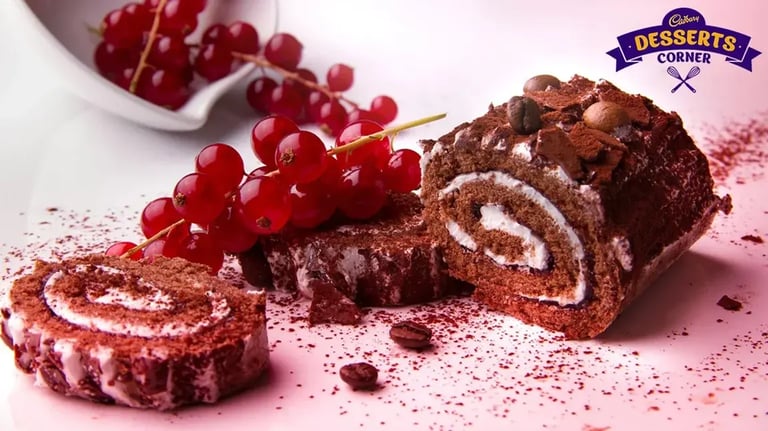- Home
- Articles
- Take a Trip to Winter Wonderland With the Vikings and Pagan Traditions That Gave Birth to The Yule Log Cake
This French Christmas staple is pure nostalgia for the French, and as Christmas has always been, it's a time for family to bond. The log cake is a specialty of the French, inspired by the ancient Nordic winter solstice tradition of burning logs for good luck.

This French Christmas staple is pure nostalgia for the French, and as Christmas has always been, it's a time for family to bond. The log cake is a specialty of the French, inspired by the ancient Nordic winter solstice tradition of burning logs for good luck.
Yule log or bûche de Noël is a classic wintertime dessert that soars to popularity during Christmas time and looks somewhat like a Swiss roll but is rich in chocolate. Yule and Noël are both old Norse terms that translate to Christmas and have intertwined significance in a ritualistic past, one that celebrates the end of winter and the other that honors the Norse god, Thor.
The Viking Connect

Old Norse was the language of the Vikings and this ancient language was spoken widely among the Nordic countries of Norway, Iceland, Sweden, and Denmark during their time. Yule was a winter holiday that was celebrated, by the Vikings, at the crux of which was the winter solstice. Nordic winters had always been harsh, and come sunshine of post-winter, it was a joyous occasion for the Vikings.
The days post the winter solstice were longer, and this celebration is significant since it celebrated the sun as it did the winter by burning yule logs, or the oak tree wood, which had runes carved into them. These runes were carved in the ancient Norse language and sought the protection of the gods. These logs burned throughout the cold winters of the Nordic countries the Vikings lived in and provided them with warmth.
The Older Nordic Communities

This is one version, another version roots it in Pagan traditions that took place around Christmas time; this is before Christmas existed. A log from any tree would be burned for 3 days straight to ensure a successful harvest for the coming year. The log before being burned at the hearth, was sprinkled with ceremonial liquids or condiments– holy water, salt, wine et cetera depending on the local beliefs of the home or region.
As Christianity spread across Europe, many of the winter solstice traditions were incorporated into Christmas celebrations. The burning of the Yule log became a Christmas tradition in parts of France and other European countries. Sometimes the embers from the Yule log would be saved and used to light the log for the following year.
As the hearths disappeared with time and were replaced by stoves where wood would be burnt, the log ritual also dwindled into nothingness. Just for the sake of nostalgia, families would place little logs on their tabletops to honor the age-old ritual of burning logs in the pagan winters. As the cogs in some imaginative chap’s head turned this table relic was turned into a dessert, not with magic but with regular ingredients and a pinch of creativity.
Beyond the Lore

While the Vikings are gone and so are those miserable days spent in the cold by the fire, oh wait they still exist, but the waking up and choosing violence has definitely gone down, a midget. While the log cake might not be the center of Christmas celebrations in the Nordic countries, for France, it has always been the staple. Because the log cake was born in France in the 19th century.
In the late 19th century, French pastry chef Pierre Lacan had the idea to create a cake in the shape of the traditional Yule log that was burned since ancient times, as was the lore. He crafted a rolled sponge cake filled with buttercream to resemble the log shape. It was iced with chocolate buttercream or ganache to imitate the bark. Decorations like pistachio crumbs or marzipan mushrooms were added to make it look like a log freshly removed from the fire.
Lacan's Yule log cake recipe was published in 1895 and became a classic French Christmas dessert. The tradition spread to other countries as well. Today, the Buche de Noel remains a beloved Christmas symbol, connecting modern celebrations with ancient winter solstice rituals through its unique log shape and festive decorations.
Pure French Nostalgia, For Others an Unforgettable Taste Expedition
What makes the bûche de Noël such a beloved French Christmas tradition year after year is its simplicity. With just a few basic ingredients, anyone—even novice bakers-can craft this festive log cake. It requires far less finesse than ornate showstoppers like the Opera Cake.
While versions vary endlessly across France, nearly everyone has memories of a bûche reminiscent of childhood. Some prefer lighter fare, swapping the buttercream for chocolate pastry cream.
The steps are easy enough for families to tackle together, a perfect excuse to bond in the kitchen. First, roll up a creamy jelly cake layered with buttercream. Frost it with silky ganache then get creative with a fork, etching the bark-like texture of a felled tree. For extra realism, slice and reassemble parts of the "log." Top with whimsical mushrooms, fashioned like the red and white enchanted fairytale mushrooms, handcrafted from marzipan—they'll cast that special Christmas magic over kids and grownups alike.
Like This Article?
More Like This




Popular Articles





Trending Web Stories
Curated Recipes


















